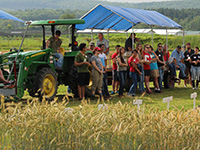 The Three Sisters | A Legend | Diversity | How to Plant the Three Sisters | Activities | Information | Evaluation
The Three Sisters | A Legend | Diversity | How to Plant the Three Sisters | Activities | Information | Evaluation
The Need for Diversity
• As a planting system, the Three Sisters has more variety, or diversity, than a planting of a single crop. In addition, native peoples traditionally plant many varieties of each “Sister.” How is this different from contemporary agriculture? Why might this matter?
• In 1970 the United States lost nearly half of its corn crop to a disease called southern lead blight. This happened because most of the planted varieties shared a single female parents from Texas. The parent passed along to each offspring a trait that made it susceptible to this disease.
• In 1845, 75 percent of Ireland’s potato crop rotted in just weeks from a disease, and a million people starved. Although more than 100 species of potato exist in Central and South America, explorers brought back a single variety to Ireland. At that time, its susceptibility to disease was unknown. Even today the world relies on twelve varieties from a single species for 85 percent of the potato harvest.
• In 1946 in the United States a blight destroyed nearly all the oat crop. Although thirty varieties were planted, all shared a single parent.
Each of these examples demonstrates the importance to agriculture of maintaining plant diversity.
What is plant diversity?
Basically, it is the differences among groups of plants, which are determined by the traits each plant group inherits. Groups of plants are classified into varieties, races, or species, depending on the degree of differences among them. Scientists have described more than 250,000 species of flowering plants and hundreds to thousands of species of conifers, ferns, fungi, and other plants.
Scientists estimate that there are more than 250 races of corn in the world, and they have described thousands of varieties. Only a few of the best varieties, however, are widely planted. When a large amount of land is planted to a single variety to ensure uniformity, the risk of a disease or insect destroying the entire crop becomes greater. This is because no variety is resistant to all potential pests.
Hundreds of plant species are eaten for food throughout the world, but the majority of food comes from only four: corn, wheat, rice, and potatoes. With the increasing world population and the decreasing use of pesticides, the species and races that can give improved yield, nutritional quality, and pest resistance must be preserved.
Diversity All Around You
Wouldn’t it be boring if everyone looked alike? Humans are lucky to be such diverse creatures! To help you think of diversity in familiar terms, look at the people around you. Although you, your friends, and your family are members of the same species, you each are unique individuals with traits that are different from those of any other human. This is an example of diversity among humans.
You can learn about diversity among plants in your own backyard. All you need are paper and a pencil.
Go outside and select a single plant species of which you can find a sizable number. Choose from wild plants such as sugar maple, dandelion, ground ivy, or goldenrod—there are many to select from!
When you have decided on a plant species, begin tracing on paper the shapes of the leaves from different plants of that species. As you do this, note the different characteristics of the leaves. Are each of the leaves exactly alike? Compare the drawings of leaf shapes. Some leaves may have fewer lobes or divisions, and some may be more deeply serrated, or toothed. Some may be much larger than others. You may note differences in other lead characteristics as well. Look for subtle changes in color. A soft fuzz may occur on some of the leaves and not on others. All of these subtle differences represent plant diversity!
Marvin Pritts, Professor, Department of Fruit and Vegetable Science, Cornell University









